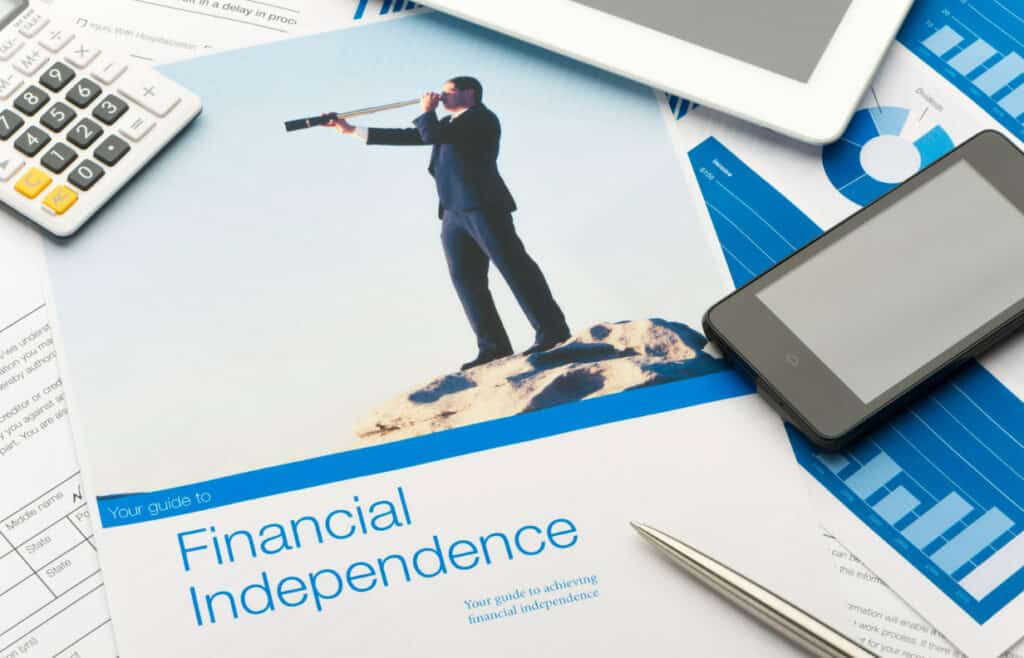Living with the freedom to travel extensively or invest in a home by age 35 may seem like a distant dream. But with ample desire, discipline, and the correct strategy, it can become an achievable goal.
Table of Contents
With a bit more life and money-handling experience under your belt, it’s possible to set up some structures and shift your mindset towards financial freedom.
Continue reading for several tips to guide you toward fiscal self-reliance, as we explore 5 simple steps to help you become financially independent in your thirties.

Understand What You’re Striving For
Reaching any objective requires a definition of success. What does it mean for YOU specifically to be financially independent? Retiring from your job by 30 and starting your own small business?
Perhaps you’d like to dabble in the stock market full-time, or return to school and earn a degree in a new field without having to worry about student debt or living within your means.
Whatever the case, begin the process by identifying clear-cut outcomes and writing them down. We suggest you get a financial planner early in the process, who can offer an expert eye over your plans, and provide a clear roadmap to achieving them.
Below, we’ve detailed a framework to help you list and reach specific milestones, to get started.
SMART Goals
Follow the SMART goals blueprint to create goals that are more defined and attainable. Your goals will need to include the following components to make them realistic.
Specific
List precise and unambiguous goals. Instead of saying, “I need to start saving money,” use an exact dollar figure you’d like to save during specific periods, or how much you’d like to have by X month.
Measurable
Decide how you’re going to gauge your progress, whether it’s using a banking or investment app, creating a spreadsheet, or calculating loan payoff months. Normalise meticulous tracking methods for any financial-related tasks.
Achievable
Set goals that are within your reach. Break down larger aspirations into smaller, more manageable chunks. Don’t set yourself up for failure with unrealistic ambitions, which means being honest with yourself about your financial limitations.
Relevant
Make sure each goal precisely aligns with your overall endgame. Make sure that what you’re striving for now is linked to the ultimate goal of financial independence, to keep you motivated. For example, ‘I’m going to eat out no more than once a week because I want to save enough money for a deposit.’
Time-Bound
Set deadlines to create a sense of accountability. This will give structure and motivation to your process, and allow you to track your progress, as well as make any changes necessary, due to unexpected life events or unforeseen hiccups along the way.
Creating Budgets
Once your goals are defined, it’s time to visualise your income and expenses. Document all your current earnings sources, including salary or wages, interest, dividends from investments, freelance income, and family or government support.
Now, list your expenses and separate them into fixed and variable categories. Standard fixed costs include rent and utilities, while variables might include food, fuel, entertainment, and non-recurring items.
Now, choose a system for tracking your budget activities that suits your habits. This might be a dedicated app, creating a custom spreadsheet, or just jotting it down in a simple notebook.
The key is persistence. Instil the habit of keeping this information current and easily readable. Now that you have the pertinent information tracked, put the data to use by creating a budget that works in your favour.
Use the 50/30/20 rule as a starting point: 50% of income for obligations and needs, 30% for wants, and 20% for savings or investments. After three months, if this method doesn’t resonate with you, adjust it based on your lifestyle or other variables. But don’t lose focus on the endgame goal.
Investing – Start Early
Assuming you have leftover funds after satisfying your monthly expenses, it’s imperative to begin the investment habit early. Use that 20% on common options that cater to your individual risk tolerance and financial objectives.
Stocks let you own a share of a company, while mutual funds and ETFs (exchange-traded funds) appeal to many investors for their diversification power. Bonds offer fixed interest over varying periods and are issued by government entities or corporations.
Employees who stick with their company long-term should take advantage of their retirement account options, such as the 401(k) retirement savings plan and IRA (individual retirement arrangements), which both offer tax advantages and savings opportunities, benefiting from compound interest gains.
Debt Management
Suppose you have outstanding balances with high interest rates. In that case, paying those off as soon as possible is imperative to prevent them from spiralling out of your control.
In the case of multiple debts, gain clarity by making a list of each outstanding figure and the associated interest rate. Then, systematically reduce the highest balances first while making minimum payments on the rest.
Once a balance is paid completely, repeat the process using the debt with the next highest interest rate. Stay consistent and committed to paying each bill on time to avoid late penalties and dings to your credit score.
While low-interest loans, such as student loans and mortgages, can be used to your advantage, it’s still vital to approach them with prudence and caution. Carefully evaluate the rewards and potential risks, and shop for the best rates and repayment terms.

Discipline & Resilience
This final tip focuses on self-control. Our digital world of instant gratification and 24/7 streams of commercialism can sometimes get us into trouble. We don’t see the effects until the statement arrives in our inbox because it’s too easy to swipe that card or click the ‘Buy’ button on our tablets.
If you’re serious about reaching financial independence, you must resist the temptation to buy the next shiny thing.
Instead of purchasing that $10 extra large latte on your lunch break daily, go to the grocery store to buy coffee in bulk. Bring what you’ve made at home into the office, along with a packed lunch.
Visualise these funds by multiplying them by 5 days a week, then calculate the annual savings. Use the money you save on your next credit card payment or transfer it to your savings account. Using discipline creates resilience through proactive approaches like these.
Be Financially Independent In Your Thirties
Think of new ways to include these habits in every part of your daily routine, and soon, you’ll be financially prepared for your thirties – free to pursue your passions and purpose without the stress or anxieties of funding them to worry about, now or in the future.
From tackling your debt early to considering affordable pathways towards investment, this article has aimed to inspire and help you know what steps to take next on your path to financial independence in your thirties.



